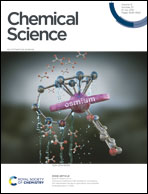Absolute configuration retention of a configurationally labile ligand during dynamic processes of thiolate protected gold clusters†
Abstract
Monolayer protected metal clusters are dynamic nanoscale objects. For example, the chiral Au38(2-PET)24 cluster (2-PET: 2-phenylethylthiolate) racemizes at moderate temperature. In addition, ligands and metal atoms can easily exchange between clusters. Such processes are important for applications of monolayer protected metal clusters; however, the mechanistic study of such processes turns out to be challenging. Here we use a configurationally labile, axially chiral ligand, biphenyl-2,2′-dithiol (R/S-BiDi), as a probe to study dynamic cluster processes. It is shown that the ligand exchange of free R/S-BiDi on a chiral Au38(2-PET)24 cluster is diastereospecific. Using chiral chromatography, isolated single diastereomers of the type anticlockwise/clockwise-Au38(2-PET)22(R/S-BiDi)1 could be isolated. Upon heating, the cluster framework racemizes, while the R/S-BiDi ligand does not. These findings demonstrate that during cluster racemization and/or ligand exchange between clusters, the R/S-BiDi ligand is sufficiently confined, thus preventing its racemization, and exclude the possibility that the ligand desorbs from the cluster surface.



 Please wait while we load your content...
Please wait while we load your content...